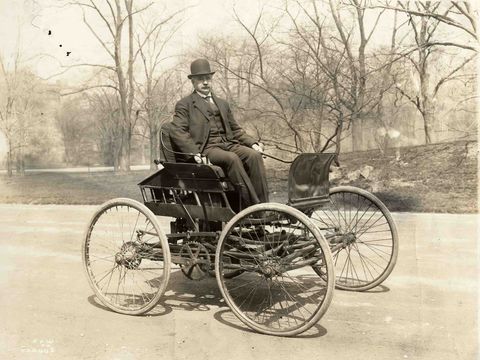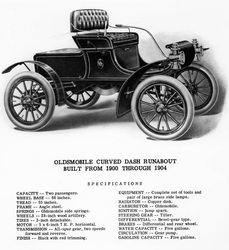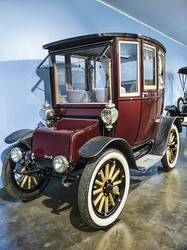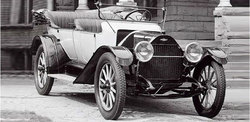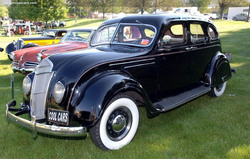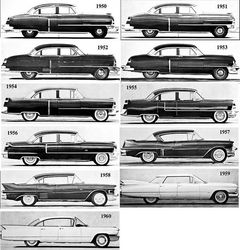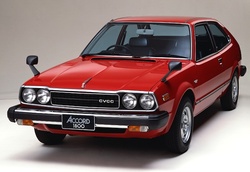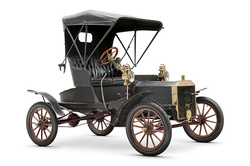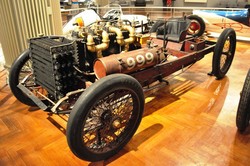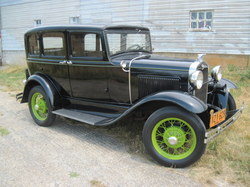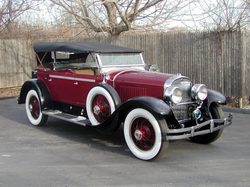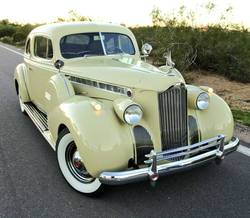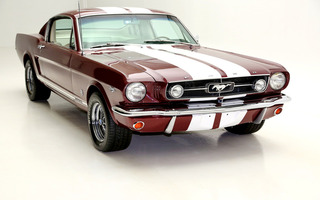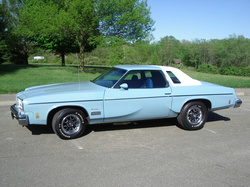Photographic History of the Automobile:
From the Early Years to Today, The Automobile is a Study in Development:
Steam busses go back to the late 1600 as experimental vehicles in Europe. There were limited steam vehicles through the 1700's and into the 1800's but were still not common. Great Britain, Germany, and France preceeded vehicle development over a hundred years before America did. The US really didnt begin serious development till after the 1860's and still in very limited numbers. It was not until the 1880's that development in this country really begins to evolve. Before 1900, steam and electric power dominated vehicle development. Basically, the truck evolved as an engine on a wagon, the automobile evolved as an engine on a buggy, and the motorcycle evolved as an engine on a bicycle.
In the US, self powered vehicles were found in either large cities or high population centers like the north east. It was not until after 1900 that the business of automobile development really began. There are a few examples of self powered vehicles before 1900 but they are few and largely experimental. The most common vehicles which could be found from 1895 to 1905 would be electric taxicabs in New Your or Chicago, or experimental vehichles which began popping up after 1895 but little materialized till the early 1900's. To be clear, self powered vehicles were really rare till after 1907. In the midwest, it didn't occur till after 1910 and cars were still rare. I have records of people in rural areas never saw a car till the early 1920's. From 1890 till 1910, self powered vehicles were rare and confined largely to large cities. Only the rich could own one. From 1910 to 1920, there was a huge turnaround. During this time period, the car became a vehicle which most felt would not replace the horse to becoming a new development which people finally recognized as being the future of transportation. After 1920, the growth of the automobile grew exponentially. By the mid 1920's, half the population owned one then by the early 1930's, nearly everyone owned a car. After WWII, car ownership grew from one car per family two two, then after the late 1950's, there was such a glut of cars, new issues such as smog and congestion emerged. From the early 1960's (this occured evelopment earlier but was secondary) safety became a huge issue. From the 1970's and 1980's, gas millage was a big issue, and since 2000, foreighn cars have been outselling American cars in America.
The car below is a "Haynes" built by Elwood Haynes. Haynes began developing his car around 1890 and for years claimed to be the producer of the first American car. It is generally understood to be the Duryea brothers (Charles & Frank) who were the first American builders of automobiles followed by Ranson Olds. There are actually a number of early builders of automobiles and always someone new is added, but these early years were formative and the machines were simple. More on this later.
Below is the Haynes automobile from around 1900: For years Elwood Haynes claimed that he was the founder of the automobile in the US. History determined that the honor goes to Charles Duryea.
Above is Elwood Haynes in one of his early cars dating around 1895-1900:
0Ranson Eli Olds began experimenting with steam engines on buggies as early as 1891 which was a 3 wheeler. His first steam car was developed in 1894 and his first gasoline car in 1896. His famous "curved dash Olds" was sold from 1900 and was the first American automobile sold in volume. It sold for around $650 which was beyond the price that the common person could pay. In 1904 Olds sold the brand and created the REO (Ransom E. Olds) which produced cars then trucks. Oldsmobile became a part of General Motors in 1909 and was discontinued in 2004.
Overview of early electric cars:
The electric automobile first emerged in France and England in the second half of the 1880's but did not appear in the US till the early 1890's. They were primarily taxicabs in larger cities, especially New York or were used by wealthy women. There were never sold in large numbers. Top speed was generally below 5 mph and were easy to operate. Women liked them because they were quiet, almost always enclosed, reliable, and didn't smell of horse manure. Although some were still used into the 1930's, they were essentailly gone by 1920. With a limit of around 40/50 miles they were basically city vehicles. There were some electric delivery trucks, however they never became particularly popular because of the slow speeds and were very limited in the distance they could travel. Electric cars were luxury vehicles used only by the wealthy and were quickly replaced by gasoline automobiles.
Below is an early Chevrolet:
William Durant conceived of an inexpensive car to compete with the Ford Model T and found it in an automobile using the name of racer Louis Chevrolet. Durant built the car from 1911 and it became a part of General Motors in 1917. Ford at the time sold more cars (the Model T) than "all other companies combined." Durant conceived of a company which would sell cars from a low price range to upper scale cars. Ultimately GM became Chevy to Pontiac to Oldsmobile to Buick then to Cadillac at the top. There were other cars in the range over the decades but these five brands were the primary ones. Ford remained the top brand till 1927 at which time GM dominated automobile sales till the end of the 1960's. Toyota is now the largest automobile manufacturer in the world.
The Chrysler Airflow models were considered to be too modern:
The Chrysler Airflow models built from 1934 to 1937 were considered to be too modern for the times. The designs were generally copies of the streamlined trains of the age though they greatly departed from the automobile design of that time period. The engine was moved forward and the rear axle moved back giving a better weight balance to the car and with the aerodynamic shape, they were more efficient moving on the road as well. The car pictured above is a DeSoto, however all the Chrysler brands had models with this advanced design. One big "Airflow" design element which was different from the boxy cars of the time was the lack of a defined rear fender. The body flowed together rather than followed the three box design of the time (a box covering the engine, a second box for the passengers, and a third box for the trunk and back of the car).
The 1950's brought a huge surge of innovations and horsepower:
The 1950's brought a decade of huge innovations and changes. The horsepower war begins, automatic transmissions overtake the manual transmission. In 1953, air conditioning becomes an option on a few cars and by 1957, nearly everyone offers it. Power steering (1953), power brakes (1952), power windows, and one piece windshields are everywhere. Fuel injection begins to develop for stgandard cars as does supercharging in a few automobiles. By the late 1950's there is a "fin" war and nearly all engines are OHV rather than side valve engines. The station wagon which had been built in low numbers from the 1930's becomes one of the big sellers from the mid 50's because of the population boom. Finally the development of outward design keeps up with the changes in engineering. Prices go up, many manufacturers suffer from an increase in union strikes, Chevy offers the Corvette (1953) and Ford the 2 seat Thunderbird (1955). Probably the most recognizable change is the increase in outward chrome and an increase in specialty models.
After the 1980's American manufacturers loose ground:
The Honda pictured above moves from being a new import to being proclaimed the "Car of the Year." Here are some highlights beginning from the 1980's"
- Chrysler buys AMC for 1.1 billion which included Jeep
- the recession of the early 1980's really hurts auto sales
- the 80's were the decade of rebates
- warranties move from 2 years, 3 years to as many as 7 years
- the Unions had to give big concessions because of the US loosing market share
- GM is even challenged more and has to close many factories
- the Japanese cars were seen as better made, more reliable, and a better investment
- Japanese car companies begin building factories in the US starting with Honda
- the big 3 American manufactirers drop to under 70% market share
- the Taurus saves Ford from financial disaster
- American cars begin copying the Japanese in design and in management style
- Honda becomes a major auto manufacturer (the Honda miracle)
The 1906 Ford Model N:
Henry Ford was forever trying to make a car for the common man. This was a problem because most cars were marketed to upper income customers. The Model N was built from 1906 to 1908. The Model R was an upscale N. The N sold for around $500. This Ford did not sell like the Oldsmobile but showed that Ford was a serious manufacturer. Ford was hoping that this would be the car to change the world but it was the "T" which did so. The Model T was actually an expensive car when first built but the development of the assembly line changed that. As more were built, the price was reduced.
Henry Ford's 999 racer of 1902:
Racing goes back to the beginning of the development of the automobile. Above is the Ford 999. Ford made the car as a vehicle to race other manufacturers in the earliest years. He raced Winton in 1903 and won. The car had a wood frame, a tiller as a sterring aparatus, rear brakes only, and a huge engine of around 1155 cubic inches. Estimated horse power was from 70 to 100, very low for the size of the engine but it would have seemed high at the time. The top speed was approximately 91mph which would have been outrageous at the time. The first significant "races" were those which went from one city to another or across the entire country. The development of automobile racing is complex and has grown into so many categories that today there is no book which covers all of them.
The Ford Model A - 1927 to 1931:
The Model T was built from 1908 to 1926 followed by the Model A from 1927 to 1931. Ford lost his market share after the "T" was discontinued and Ford never gained sales leadership as a company again. Many times Ford sold more cars than Chevrolet but Ford never equaled the sales of GM as a company. The Model T was outdated and loosing sales quickly so Ford was forced to update his car. As essentially a one model car with many variations, Ford could no longer compete with GM. Ford added Lincoln (1922) and Mercury (1938) but the gulf could never be breached. Unlike the Model T, the "A" could be ordered in more colors. Over time, the Model A was to outsell the GM Chevrolet. Ford was to become one of the largest farm tractor manufacturers in the world.
The 1920's Cadillac brand, pictured below, was founded by Henry M. Leland who had a great deal of influence within the early automotive community:
Henry Leland not only started the Cadillac motor car company but started the Lincoln automobile as well. Born in 1843 and living till 1932, Leland had a huge influence on the automobile. Leland had great influence in several important areas. First, he brought "precision" machining to the industry by creating the highest standards and demanding that those standards were met. Secondly, he created the first automobile which used "interchangable" parts. This had a massive influence on automobile production techniques in the early years. Thirdly, he helped develop the first "electric starters" in 1912 and Cadillac was the first to make them standard. He created the Cadillac brand in 1902 and sold it to GM in 1909 and Lincoln in 1917 which was sold to Ford in 1922. Leland was a man who had a high level of integrity and was respected greatly by teh early automobile manufacturers.
An early 1940's Packard:
The Packard shown above was a luxury car which was elegant, well built, and pricy for the time. The cars of the 40's were stiffled by production stopages from 1942 to 1946 due to the war effort. The new cars which were offered after WWII were warmed over pre-war automobiles. The cars of the 1940's were longer, lower, broader, and became more advanced in terms of engineering rather than simply looks. By the late 1940's, semi-automatic transmissions were beginning to emerge and by 1948, Buick had the first fully automatic transmission. Sealed beam headlights begin during this time period as did tubeless tires. Brakes became better, horse power increases were on the rise, and after the war, car sales went out the roof for a few years because of the production stopage. Manufacturers could sell anything and prices were often above the list price. The 1950's opened the door for serious design developments.
The 60's brought a huge growth in models and sizes of cars:
The 1965 Mustang pictured above was a game changer! The 1960's brought brand shrinkage to bring the big three, GM, Ford, and Chrysler. The 60's brought the econemy cars (Corvair, Falcon, Comet, Valient), mid size cars (Fairlane, Tempest, Olds F85), pony cars (Mustang, Camero, Barracuda), muscle cars (GTO, GTA, Chevelle SS, Roadrunner, Super Bee, etc.) and the huge growth in foreign cars (VW, Fiat, Renault, Datson (Nissan). The horsepower race also goes into overdrive. It must be noted that many imports began to enter the country during the 1950's but they grew exponentially during the 1960's to finally challenge the american manufacturers. GM had become the largest automobile manufacturer in the world.
The 1970's brought huge changes to the American automobile market:
The 1975 Oldsmobile Cutlass pictured above was a popular car during the 1970's. Here were the big changes which occured during the 1970's:
- the muscle car diminished in market share and by 1973 horsepower was down
- compact cars become the big sellers over the larger models
- gas milage, safety concerns, and pollution issues (emissions) dominate
- the global market gets much larger
- the American manufacturers still attempted to build big gas guzzlers and lost market share
- GM in particular looses sales and made cars with many mechanical problems
- foreign car sales grow exponentially especially from Japan
- American manufacturers having been used to building big rear wheel drive cars had to re-tool to make small compact front wheel drive cars which many foreign manufacturers were already making
